Teaching Kids To Sail — A Learning Experience
I volunteered to help out at the Charlotte Harbor Community Sailing Center July 2010 Kids Summer Sailing Camp. I am not an experienced Sunfish sailor, nor do I have any coaching background, but I'm an enthusiastic sailor and the Center can always use any help that comes along!
Because the Sailing Center only has one small inflatable dinghy, I also offered to bring our 15' Boston Whaler as an additional safety boat. The Camp is run by Dennis Peck, with coaching assistance from local sailors Bob and Jeff and background work, accounting, and occasional coaching from other Sailing Center volunteers.
Day one started out calm with a drizzling rain, and we waited it out inside while getting all the paperwork sorted and checked, then the kids got a brief lecture on the basics of sailing and safety before we headed outside. Dennis did not want to bore them all day with sailing theory, so we went straight into a lesson on rigging and launching one of the Sunfish.
This first photo (top right) shows a group of kids, still acting rather awkward around each other and completely unfamiliar with the boat. By the end of the week, they were displaying teamwork in rigging and sailing these boats themselves!

We got a few boats rigged and launched, and still there was no sign of a breeze. Coach Dennis put each kid in a Sunfish and gradually leaned it over a bit to simulate how it would feel under sail, then capsized the boat, to get the kids used to how to right it. Once they had all been through the capsize drill, Coach Bob invented some Sunfish paddling races for the kids so that they could start to learn how to steer the boats and how to avoid getting hit by the boom.
Their paddling efforts were marked by more enthusiasm than competence at first, but they gradually figured out how a team of three kids could successfully get a Sunfish moving. Once they got that down, the rules of the race were changed to include making the kids capsize the boat out on the race course. Standing in the water nearby, Bob and I were laughing really hard at their efforts, but greatly pleased when they all did it successfully.
I was beginning to think we would have to put away the boats without letting the kids sail at all on that first day, but on the very last "paddling" race a little breeze came up. Not much, but enough to move a Sunfish much faster than the kids could paddle it.
One boat caught the breeze and sailed out, while the other two got a bit tangled up trying to clear the small channel through the rocks before getting under way, but at least all the kids got to feel the sensation of movement under sail.

Day Two: Sailing And Struggling
Day two of the kids' sailing camp started out looking great. A light breeze on the harbor, as is normal at this time of year, promised to make learning to sail a lot more fun than the paddling races of the previous day. Since a couple of the kids were too small to right a Sunfish alone, we had them rig up two Optimist prams along with their Sunfish. It brought back memories of my own Optimist pram, which I bought after attending the Coral Reef Yacht Club summer sailing camp in Miami back in 1976. I had a great time with that little boat, and spent all my money upgrading hardware and making it look good. Some things never change, as I still tend to do that with boats!
Soon we had a small group of kids sailing Sunfish and prams around a short bouy course, and they started to show just how much they had to learn, and how hard it can be to avoid confusing them. A common mistake was to attempt to sail too close to the wind, so I would tell the kid to "fall off," which any sailor knows means to steer the boat away from the direction of the wind. Most responded with a confused look, so I would say, "Steer to starboard! To the right!"
Most were still unaccustomed to steering a boat with a tiller, and would respond by putting the tiller over to the right, which makes the boat turn left. "The other right," I would holler, and they would swing the tiller over that way. By this time, with no wind in the sail and the rudder going back and forth creating a lot of drag, the minimal momentum of the boat had been used up, and it would come to a stop, still pointed more or less upwind.
Sailors call this situation being "in irons," and we had told the kids how to get out of irons. The problem was, the kids did not yet recognize that their boat had come to a stop and would soon start moving backward. The next thing they knew, I was telling them to put the tiller over in the opposite direction. I could just tell that some were thinking, "Why is this old guy speaking in a language I don't know, then giving me one instruction followed almost immediately by the opposite instruction?" They did not yet understand that at the moment I told them to fall off, that was the right thing to do, but a few moments later it was no longer possible, and a different (opposite) action was necessary.
Fortunately, Coach Bob was out in the Sailing Center's RIB dinghy, and he is a lot better than I am at coaching the kids on the water. They were just starting to get the hang of it, learning to switch sides of the boat on tacks and jibes, learning how the boat would respond to moving the sail in and out when sailing at different angles to the wind, and developing the techniques to do it all without getting their sheet lines tangled up, losing control of the tiller, or getting hit on the head with the boom. It was all going really well, until the wind picked up a bit.
At first, the kids had the same reaction every sailor has to a freshening breeze: they screamed "Woo Hoooo!" as the boats took off at unprecedented speeds. It put a smile on my face, but that did not last long. The kids were reluctant to steer the boats upwind and also reluctant to fully trim in the sail because they could feel that either of those actions made the boats feel like they would capsize. A couple of them did capsize pretty soon, and Coach Bob and I had our hands full going around trying to help some kids right their boats and convince the others to sail upwind.
We both knew what the kids could not yet recognize: both wind and tide were now slowly driving our little fleet down onto the lee shore. I tried to buy some time by instructing the kids who were doing well to sail out into the harbor so that I could maneuver close to the seawall and pier at Punta Gorda's Gilchrist Park and get the boats in that area out of trouble. Some obeyed better than others, and the result was that we had a few boats out in the open harbor, slowly being blown down onto the US 41 bridge, a few boats closer to shore, slowly being blown down on the beach by the Best Western hotel, and a few boats up nearer the Sailing Center, being blown down toward the seawall and pier.
One of the boys capsized his Sunfish a short distance from the pier and was having trouble righting it. I went over to assist, and stopped my boat where I could reach his centerboard. I could tell immediately that the mast was stuck in the mud and we were not going to get it out easily. Dennis yelled to me from the seawall to leave the boat and go tow the other kids in off the harbor while Coach Bob gathered the ones down by the beach. I snatched the kid aboard and took off after the other boats, telling each kid to drop his sail and secure it on deck so that I could take them in tow.
By the time I returned, Dennis had swum out to the stuck Sunfish, righted it, and dropped the sail. I swung by to pick him up, and saw him start to get in the boat, then just tell me to tow it with him dragging alongside. I did not like seeing him too exhausted to bother getting in the boat. One of the main reasons I volunteered to help at the Summer Sailing Camp was to try to prevent Dennis from doing things that might result in his having yet another heart attack, and I was very upset as I slowly towed him along. With all due respect to the dedicated crew of Sailing Center volunteers, I think most would agree that there would be no Sailing Center without Dennis.
By the time we got the boats back to the Sailing Center, it was lunchtime and we all took a break. The wind was still a bit too strong to send the kids back out. It is hard to get a group of kids to pay attention for more than a minute or two at a time, but Coach Bob has the remarkable ability to be the center of their attention for a couple of hours at a time. We had them put away most of the boats, then he stood in the water as each kid in turn got into one boat, while the rest stood around and watched. He had them "sailing" in place upwind, simulating tacking, reaching and then running on the other tack, then jibing back around to their original upwind configuration. With a pretty good breeze in the sail most of the time, Bob was working pretty hard to control the boat in the waist-deep water. I'm not sure which is harder, manhandling a Sunfish for two hours or getting a bunch of kids to pay attention for that long, but it was a pretty amazing performance.

Day Three: A Perfect Sailing Day!
Our third day of the Sailing Camp was just fantastic. We had the perfect breeze for teaching all day long, which is very unusual here in the summer months. There was enough wind to make the boats move along nicely, and enough that a serious mistake would result in a capsize, but it was light enough that the kids could make small mistakes and learn to recover, unlike the previous day, when any mistake meant an immediate swim.
I watched them start to learn how to shift their weight in response to small changes in wind speed, how to make their way upwind without getting stuck in irons, and how to tell whether their sail is properly trimmed.
We had them sailing around a small triangular course, and I had anchored my Whaler in the center of the triangle, holding Dennis alongside in the RIB. Three volunteer coaches were sailing along with the kids, giving individual instruction at close range and demonstrating proper techniques on their own boats, while Dennis and I gave helpful hints to the other boats.
After they got the course down well enough that they were making it around with few mistakes, we told them to reverse direction and navigate the course the other way. I was surprised at how difficult this turned out to be, even for the best of them. When they got to the upwind leg, which had been a downwind leg, I saw many boats trying to sail too close to the wind, some still winding up stuck in irons as they failed to recognize and correct the situation in time. In the picture on the left, Sunfish number Zero is being piloted by a couple of previous sailing school graduates, and is the only one properly sailing upwind after we told them to reverse their direction of travel around the bouys.

Learning Tiller Steering
It was a surprise to me that so many kids seemed confused by the act of steering the boat with a tiller. By the time I learned to sail, I was already accustomed to steering small outboard dinghies, so using a tiller to steer a sailboat was relatively easy for me. Most of the kids seemed to take a little time to get the feel of pushing or pulling the tiller in the opposite direction of the intended turn.
Sailing a small boat is a bit like riding a bike. Once you get the feel of it, you lean and turn without really thinking about what you are doing. Watching the kids learn to steer was a bit like watching kids learn to ride a bike when they do the wrong thing and it goes out from under them.
Just before the picture to the right was taken, the two boats were on course for the downwind mark. I watched as the boy on the left got a little off course, then started pulling his tiller the wrong way in an effort to correct his course. I took the photo as he pulled the tiller way too far in the wrong direction, after which he snapped it back the other way, getting back on course but effectively killing his speed. Most of the kids did this several times, but as the day wore on, they did it less and less. Their bodies were starting to learn to steer without thinking, like they would on a bike.
Another common mistake was losing control of the tiller during tacks and jibes. They had not yet learned to smoothly hand the tiller from one hand to the other during these maneuvers, and once you let a Sunfish tiller go, it can quickly get out of reach. Diving over to reach it as the boat careens out of control will frequently result in a capsize, as happened to the boat pictured at left.
The kids learned various ways of capsizing a Sunfish that day, and they learned that they could right the boat and sail away and it is all part of the experience of small boat sailing. A couple of them complained to me that the sheet line got tangled up around the tiller or caught on their life jacket, the centerboard fell out, and other things, and I typically had one response, "Yeah, that happens, solve the problem and sail on."
We wanted to teach them that things will happen on a boat, and we expect them to analyze and deal with the situation and learn to avoid it in the future. We would offer some helpful hints if they appeared to be needed, but did not want the kids to learn to rely on asking a coach every time something unplanned happened.

In the afternoon, we put one of the kids into an O'pen Bic sailboat. He seemed a bit small for Sunfish and a bit bored by the prams, so the Bic offered more fun in a small package. Unfortunately, no one put the plug in the boat prior to launching, and the hull soon filled with water. The poor kid was capsizing one direction and then the other as the water sloshed around inside, making the boat hopelessly unstable. After dragging it out to drain, he had better luck sailing it. The O'pen Bic is very responsive to the rudder, and this made the novice sailor's tendency to overcorrect when steering a problem.
I could not resist snapping a picture when I saw Dennis heading out on the O'pen Bic, sailing it from a standing position. Don't try this at home, kids!

It is rare, especially in the summer months, for the small sailboat racks at the Sailing Center to be nearly empty. Nothing makes Dennis happier than seeing all those empty spaces and knowing a lot of new sailors are out enjoying themselves in the boats on which he works so hard. Dennis, this picture is for you!
The kids had a long day of sailing on day three of their camp, and at the end of the day they were working in teams to put all the boats back on the racks and all the rigs back in the black storage tubes. In the picture to the left, you can see a group of kids working a Sunfish into the rack under the watchful eye of Coach Bob, who was making sure that kids and boats did not get hurt in the process. When it was all over, all of the kids were completely exhausted, and a couple even decided to lie down on the lawn, despite the ever-present fire ants. I'll bet they slept well that night!

Day Five: Growing Competence and Confidence in the Young Sailors!
I missed the fourth day of sailing camp, but got back out there for day five, which turned out to be another great sailing day. The breeze was pretty strong for a July day in Florida, about as strong as the wind that blew our fleet down the harbor on day two, but with a couple of important differences. This time, it came from the southeast, so the kids were sailing along a protected windward shore, not a choppy lee shore. If they sailed close enough to shore, the wind dropped significantly. More importantly, they had just been through a couple of days of sailing in a bit less wind, and they were prepared to handle a step up in wind speed.
When I arrived, Coach Bob had the kids gathered for a morning briefing. They were a much tighter group than they had been that first day, and were rigging their boats with confidence by the time I moored our Whaler and slogged ashore. There were still a few stumbles, but it was quite a change from those first couple of days. By now they knew little details like how to get the boats down the narrow ramp accurately and without scratching them.
Soon we had a bunch of Sunfish sailing around and I could hear the kids (and some of the coaches) whooping it up as their boats sped along. You do not have to be going all that fast in a Sunfish before it feels fast, and feels like it might go out from under you at any moment.

Some of the kids went out in pairs, so that the ones who were doing better could help the others along, and so that they would have the combined weight needed to control the boats in the stronger winds. Instead of wiping out in the gusts, they were learning to use their weight to control the boats, and learning to ease the sheet or head upwind a bit without getting stuck in irons.
Some went sailing with three to a boat. Sending them in pairs or trios seemed to help some more than others, with some kids picking up techniques well from watching others, while others seemed to be just along for the ride until they were alone in a boat. Once there was no one else to lean on, they could suddenly sail on their own. It was fun for me to watch how the different individuals learned things through the course of the week.

The kids were starting to learn how to use the hiking strap to get their weight out over the side of the boat.
They were also getting much better at tacking onto the lay line for the upwind mark and adjusting course while trimming the sail as the wind shifted.

In the early 1900s, a fish fertilizer factory was built at the site of the current Punta Gorda Boat Club at the end of Berry Street, right next door to the Sailing Center. They put a protective wall of rocks outside the facility, and most of those rocks remain out there today, submerged under a foot or two of water. There are three breaks in the wall, each marked by a pair of PVC pipes, and if the kids miss the channel, the rocks stop them, damaging the centerboard and possibly the boat. There were some nerve-wracking moments earlier in the week as they attempted to negotiate these narrow gaps in various wind conditions, but by day 5 they had learned to sail right in with no problems.
There is no dock at the Sailing Center, just a long mooring line stretched out from the shore, and the kids had to learn to sail their boats up near the line, stop and jump out, then tie the boat in its place along the mooring line and drop the sail. It is not all that easy for a newbie, and there are rocks and other boats in the small available space. We had to keep a "catcher" nearby at first, but I was pleased to watch them all sail into the little harbor, bail out of their boats, and control them with ease.
It was great fun for me watching the kids learn teamwork when it was needed, and learn individual sailing skills in their own ways as the week progressed. As they put the boats away at the end of that last day, I could see why Dennis loves doing this so much, where Bob gets his endless energy and enthusiasm, and why I want to continue to volunteer to help out at the Sailing Center. Turning a group of kids who had seldom or never been aboard a sailboat into a group of novice sailors was a fascinating and satisfying experience.
The following day was one of the Center's Youth Sailing Saturdays, and naturally many of our camp participants and previous students showed up to sail. They had great fun taking their parents out for a sail and showing off what they had learned. My wife and I brought our Hobie Adventure Islands out, and I also convinced her to try out a Sunfish for the first time. She has sailed a fair amount on cruising boats over the years, but had never sailed anything like a Sunfish. She soon learned that losing control of your tiller during a jibe can mean an unplanned swim! After capsizing, she did not seem to be having that much fun, but once on shore she did say that she wants to try it again. As we were eating hot dogs with the Sailing Center gang, I asked Dennis when was the last time he had lost it and capsized a Sunfish, and he thought about it and said it had been about a month. She seemed to feel better after hearing that, knowing that I consider Dennis a far better Sunfish sailor than I am.

Video from the July 2010 Charlotte Harbor Community Sailing Center Kids Summer Camp:
Shop for Sunfish sails, rudders, spars and other Sunfish hardware here.
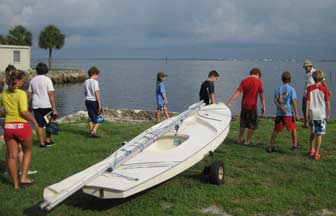
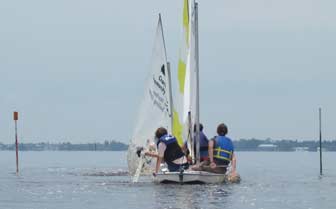
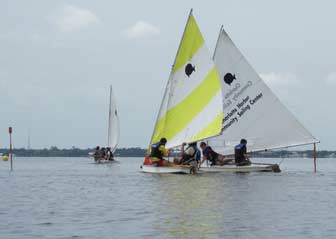
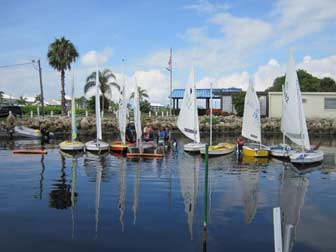
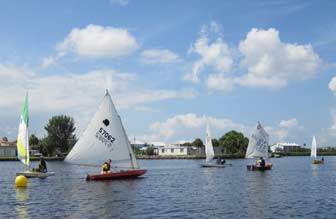
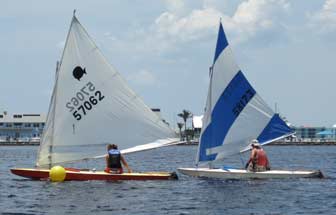
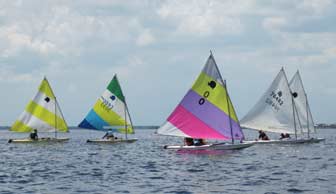
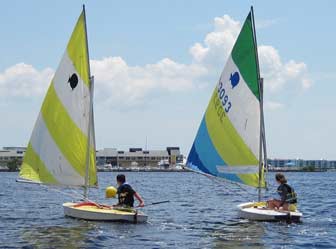
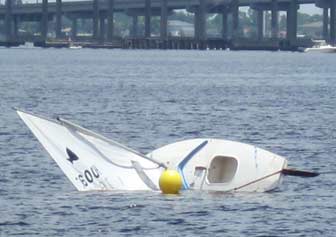
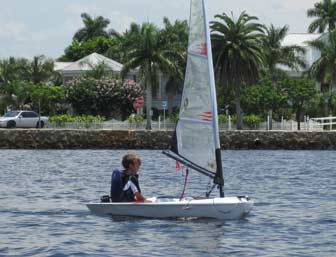
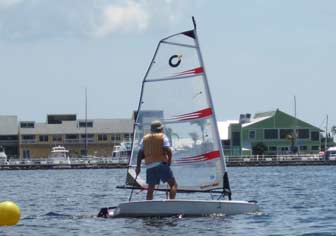
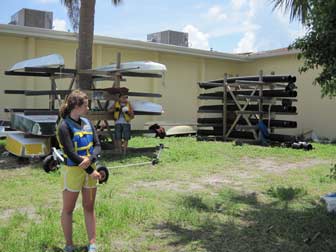
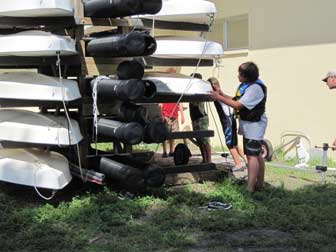
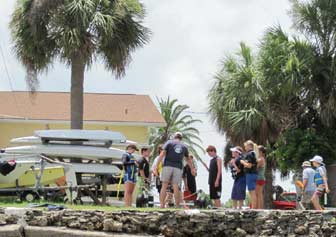
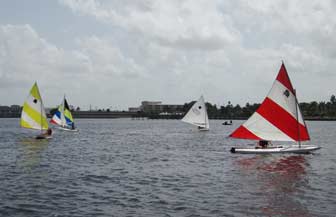
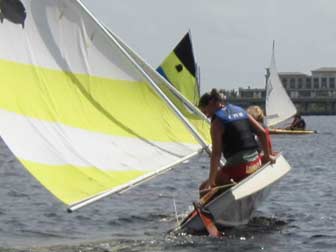
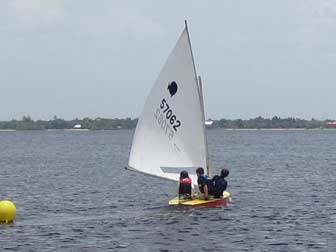
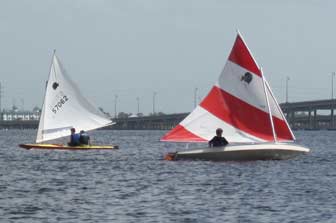
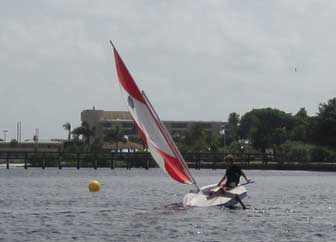
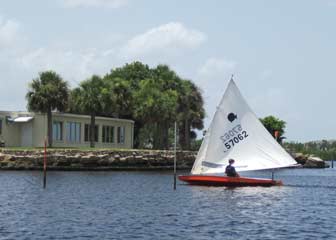
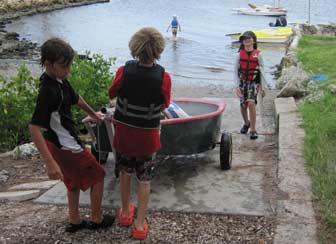
Leave a Reply
You must be logged in to post a comment.